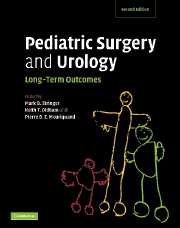Book contents
- Frontmatter
- Contents
- List of contributors
- Acknowledgments
- Preface
- Part I General issues
- Part II Head and neck
- Part III Thorax
- Part IV Abdomen
- Part V Urology
- 41 Introduction
- 42 Upper tract dilation
- 43 Posterior urethral valves
- 44 Vesicoureteric reflux
- 45 Genitoplasty in exstrophy and epispadias
- 46 Feminization (surgical aspects)
- 47 Hypospadias
- 48 Bladder exstrophy
- 49 Surgery for neuropathic bladder and incontinence
- 50 Non-neuropathic bladder–sphincter dysfunction
- 51 Undescended testes
- 52 Circumcision
- 53 The single kidney
- 54 Multicystic kidney
- 55 Urolithiasis
- 56 Gonadal tumors
- Part VI Oncology
- Part VII Transplantation
- Part VIII Trauma
- Part IX Miscellaneous
- Index
- Plate section
- References
44 - Vesicoureteric reflux
from Part V - Urology
Published online by Cambridge University Press: 08 January 2010
- Frontmatter
- Contents
- List of contributors
- Acknowledgments
- Preface
- Part I General issues
- Part II Head and neck
- Part III Thorax
- Part IV Abdomen
- Part V Urology
- 41 Introduction
- 42 Upper tract dilation
- 43 Posterior urethral valves
- 44 Vesicoureteric reflux
- 45 Genitoplasty in exstrophy and epispadias
- 46 Feminization (surgical aspects)
- 47 Hypospadias
- 48 Bladder exstrophy
- 49 Surgery for neuropathic bladder and incontinence
- 50 Non-neuropathic bladder–sphincter dysfunction
- 51 Undescended testes
- 52 Circumcision
- 53 The single kidney
- 54 Multicystic kidney
- 55 Urolithiasis
- 56 Gonadal tumors
- Part VI Oncology
- Part VII Transplantation
- Part VIII Trauma
- Part IX Miscellaneous
- Index
- Plate section
- References
Summary
Introduction
Vesicoureteric reflux is important because of the association with recurrent urinary tract infection and congenital renal problems and the tendency for renal scarring to develop in some cases. Much of the early data were derived from postmortem material but, in the last 30 years, cases have been identified during life as a result of radiological investigation of children following urinary tract infection and, more recently, because of antenatal screening or family history. Since the advent of antibiotics, the natural history of reflux, urinary tract infection and renal scarring has improved considerably and now it is very rare for a child or young adult to die from urinary tract infection or acute pyelonephritis. Although the prevalence of reflux nephropathy appears to be falling, this remains an important cause of end-stage renal failure in both children and adults. There are interesting differences in natural history and clinical presentation between boys and girls.
Historical aspects
The valvular nature of the vesicoureteric junction was recognized in medieval times, when the pig bladder, filled with water, was used as a football and ligation of the ureters was found to be unnecessary. In the seventeenth century, pathologists observed at post mortem examination that urine flow from bladder to ureters did not normally occur in humans. The role of vesicoureteric reflux as a host factor, causing and maintaining urinary tract infection, was proposed 100 years ago by Sampson.
- Type
- Chapter
- Information
- Pediatric Surgery and UrologyLong-Term Outcomes, pp. 555 - 582Publisher: Cambridge University PressPrint publication year: 2006

